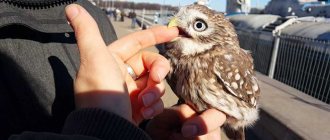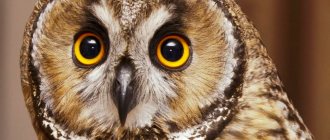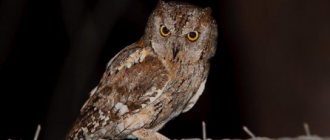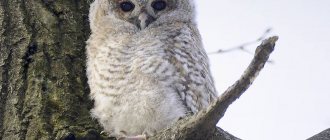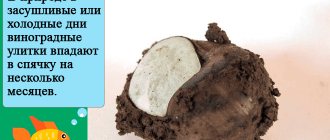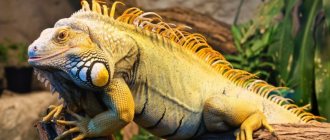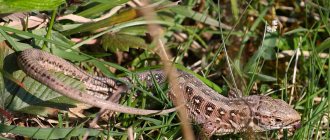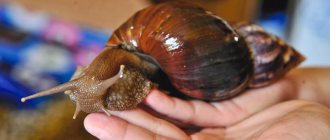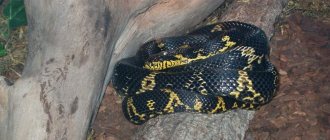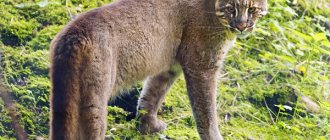- Wild animals
- >>
- Birds
The barn owl is the oldest branch of the order of owls, which can be observed by the richness and diversity of fossil forms. The unusual appearance significantly distinguishes the bird from other owls. You can verify this by looking at the barn owl's face. It can be compared to a mask, a monkey's face, or a heart. The bird has many nicknames, which are reflected in folk art. The barn owl lives close to people and is not afraid of the neighborhood, which makes it possible to keep this predator indoors.
wonderful bird
In Latin, the name of this bird sounds like Tyto alba, which translated into Russian means “common barn owl.” This bird is found almost anywhere in the world and has another common name - barn owl. On average, its length reaches 33-40 cm, and its wingspan, as a rule, does not exceed 95 cm. Its weight is small - no more than 700 g.
Barn owls attract attention due to their pretty appearance, and they also have very soft, pleasant-to-touch plumage. And the main distinguishing feature of this species from others is the facial corolla, which has an original heart shape.
People's attitude
The barn owl has always been a symbol of wisdom among people, but at the same time they treated this bird with superstitious fear. Now superstitions are becoming a thing of the past, and people are increasingly showing genuine interest in it. Barn owls inspired fear in people because of some of their features: a white face that resembles a mask, frightening sounds, and also because of the habit of this bird to fly up silently and suddenly appear in front of a person, for which people called it a ghostly owl.
The barn owl mainly feeds on rodents, thereby benefiting humans. People have long valued the help of these owls in exterminating pests. So, in the 17th century, the practice spread when special windows were made in houses, barns, mills and other buildings through which barn owls could enter and destroy rodents. In this way, the birds remained well-fed, and benefits were brought to humans.
If they notice people nearby, they begin to behave very interestingly: they rise high, sway on their legs in different directions and at the same time make various grimaces. If you get very close to it, it usually flies away.
Difference from other species
In addition to the facial disc, which has a pronounced heart-shaped shape, the barn owl, a photo of which can be seen in our article, differs from its fellows in its lighter plumage. These birds have a peculiar structure of the hearing apparatus: their right ear is located at the level of the nostrils, and the left ear is located at the level of the forehead. Thanks to this arrangement of the owl's organs, barn owls have truly perfect hearing. They are able to pick up the sounds of a potential victim over a huge range and from different angles.
How long does he live?
The average life expectancy of owls in natural conditions ranges from 5 to 15 years. This wide variation is due to many factors. The bird is forced to get its own food, and also periodically encounter larger predators. Because of this, the animal’s body gradually wears out, and many individuals do not even live to be 10 years old.
Owls quickly adapt to artificial habitats
Interesting fact : Eagle owls live longer than other types of owls. The world record belongs to an individual who lived for 24 years and 9 months in the natural environment.
In an artificial environment, the life expectancy of owls increases significantly. Because people care for them, birds do not need to expose themselves to danger and physical stress. In such conditions, their lifespan is extended to 30-40 years.
Barn owl: where is it found?
Most often the bird can be found in wastelands, ravines and swamps. Under natural conditions, the barn owl, photos of which are presented in the article, prefers to choose open plains for settlement, where there are a small number of trees.
These birds also love to settle near human habitation and rural farms. Human activity in clearing forests and cultivating land, unlike many other predators, only benefits barn owls. Human agricultural work makes it much easier for the owl to find food.
Distribution area in nature
Barn owls live throughout the world, with the exception of Antarctica and the northernmost regions of Canada and Europe. Intolerance to severe frosts is associated with the inability of these owls to accumulate significant fat reserves. They also do not like the desert climate, as well as high mountain regions. The species was specially moved to some countries by humans, for example, to the Seychelles and Hawaiian Islands.
Did you know? In the Seychelles, barn owls hunted not only rats, which was the purpose of their settlement in 1949. They also attacked the local species of kestrel, causing a sharp decline in the number of these birds.
Features of behavior
In the wild, this species prefers to lead a solitary lifestyle. At the tips of their wings, these birds have specific flight feathers, due to which their flight is cushioned, becomes very soft, smooth and almost silent. These owls have almost perfect vision and can navigate perfectly both in daylight and in pitch darkness.
If a person approaches a wild owl, then, as a rule, it immediately rises into the air, may begin to sway from side to side, and even begin to make various funny faces. They prefer to lead a sedentary lifestyle and can live in the same favorite place for years. Only a lack of food can send an owl in search of a new place.
The barn owl is active exclusively at night, but during the day it mostly prefers to sleep. During the breeding season, barn owls can make various sounds - shrill screams, hoarse hoots, and sniffles. During calm periods, birds like to click their beaks or click their tongues.
Popular subspecies
Ornithologists identify 16 species of barn owls, and the most common of them is the barn owl. It, in turn, has 35 subspecies.
Among other owls of this species it is worth mentioning:
- Madagascar barn owl, whose name corresponds to its habitat. A rare species on the verge of extinction. This small bird (up to 27.5 cm long) has a longer tail than other barn owls, brown spots under the eyes and a beautiful pattern of dark mottled large spots on the wings and near the tail;
- golden barn owl, up to 33 cm long with V-shaped spots on the red-gold plumage. Its facial disc is also light ocher in color. The owl lives on one of the islands in Papua New Guinea and there is very little accurate information about it;
- The Australian barn owl is distributed both on the fifth continent and on neighboring islands. Distinguished by its reddish-brown facial disc, strong beak and legs;
- The black barn owl lives on the islands of New Guinea and Yapen, and is occasionally found in eastern Australia. The bird's ash-black plumage is combined with a light gray facial disc, on which very large black eyes stand out. Owls chirp and chatter like insects, and also emit a downward whistle reminiscent of a flying bomb.
Food for cute owl
The cute heart-shaped face, funny habits and expressive eyes of the owl can mislead many. Being in a state of emotion, people sometimes forget that this bird is a real predator. Those who think that a barn owl at home can eat like an ordinary parrot are greatly mistaken. It is necessary to understand that oats, millet and fruits will not be enough for her.
The basis of the owl's diet consists of various rodents. These could be hamsters, field mice, gerbils, gophers, rats. In nature, these owls can hunt reptiles, invertebrate animals, shrews, and possums. If necessary, the barn owl can also feast on other small birds, frogs and bats.
Food supply.
In nature, owls eat rodents, small birds, insects, and sometimes reptiles and amphibians. Some owls can fish. This is the kind of food your owl should receive.
No half measures or store-bought substitutes. Beef, pork, chicken and their by-products will all painfully and slowly kill your bird. IT IS FORBIDDEN.
Mice, rats, and hamsters are sold for animal feed - this is the main good food for an owl.
If we are talking about house owls, scops owls, and scops owls, then food insects are also suitable for them: crickets, food cockroaches, locusts, zoophobes, etc.
Very detailed articles on feeding owls in captivity: What to feed an owl. About feeding owls in captivity. Plant foods, dairy products, game.
You should have constant and uninterrupted access to such feed.
You will have to learn how to kill cute little animals yourself. No, you cannot give a pet owl a live rat and have the owl kill it itself. You will have to kill the rat, butcher it, removing excess fat, and only then give it to the owl.
Small owlets need to be fed with pieces of carcasses, even cutting mice into 5-7 pieces.
7
. Socialization. If you get an owl at home, then you will have to realize and accept the fact that
Features of digestion
Even if a person is not embarrassed by the need to feed the bird with living creatures, it is necessary to pay attention to the special process of digestion. A barn owl at home must receive live food. Some owners try to cheat and feed the birds simply fresh meat, chicken and rabbit hearts. Such food can completely upset your pet’s digestion.
The barn owl, like other representatives of its genus, has a specific digestive tract that needs to digest wool and bones. After eating its prey within a few hours, the bird forms a pellet. This is the pellet that an owl spews out after eating, and it consists mainly of undigested bones, fur and feathers. It is very important to ensure that the pellet comes out after each meal. After this, it must be removed immediately by the owners, since owls, foolishly, may eat it again.
How to choose the right pet and where to buy it
If (despite all the specifics of keeping an owl at home and the difficulties ahead) a decision has been made to buy a bird, you need to know where this is being done. Today the supply for these wild predators is quite large. But you should not buy an owl online or at the bird market. Firstly, it may be sick, and secondly, it may be a freshly caught, completely wild individual, which will be very difficult to accustom to life in an apartment.
The ideal option for purchase is specialized nurseries, where they advise purchasing young chicks. Also, employees will be able to advise owners on any questions and tell them what to do next after the purchase.
Each owl taken into the nursery has a special ring on its paw with a number stamped on it. When purchasing, it is important to ensure that the numbers on the bird’s documents and on this ring are identical. If there is such a possibility, after purchasing a pet, it is recommended to show it to an ornithologist or at least a veterinarian. The doctor can take the necessary tests, order an x-ray and conduct a full examination, thereby determining the general condition of the bird.
So, you have delivered the owl to its new home. Naturally, she may be scared and confused. You should not annoy her with your attention by constantly touching her. The box with the bird should be placed in its new room, opened and the owl left alone until it crawls out on its own. Most likely, she will constantly hide, and this state of stress can last about 3-4 days.
Arranging a cage or room for an owl
The ideal option for the bird to live would be a separate room. All sharp objects and corners that may pose a risk of injury to the bird during flight must be removed from the room or covered with soft material. It is also necessary to allocate a corner for sitting, but, as a rule, the owl chooses a perch on its own, having chosen a certain place.
If you decide to keep a bird in a cage, it must be large in size so that you can fly in it with its wings fully extended. Also, do not forget that when kept in a cage, the owl must regularly leave it, walk and fly around the apartment so that its wings do not atrophy.
Clean drinking water must be available within reach at all times. It is recommended to change the water at least twice a day.
Description
The color of most species contains dark tones, which allows them to remain unnoticed at night and makes hunting easier. Most species have gray, black and dark brown colors on their feathers. Moreover, almost always one shade is predominant, and the rest are present in the form of spots.
Owl head close up
The owl's head is large and round in shape. In the center there is a short beak, and on the sides of it there are large eyes. Due to the structural features of their necks, owls can turn their heads 270 degrees. The bird has a wide viewing angle, and thanks to its excellent vision, it is able to discern any details of the surrounding space. Owls see the world in black and white.
Interesting fact : owls' pupils always look forward, since the bird cannot rotate its eyes. But this is easily compensated for by the large angle of rotation of the neck.
The owl's body is massive, its front protrudes forward. The bird stands on thick paws, at the ends of which long claws protrude.
Features of bird care
You need to carefully monitor the beak and nails of owls living at home. If there is any deformation or damage to the beak, the owl should be shown to a doctor. Regarding nails, almost all owners cut them for their pets, because they are very sharp in owls and often lead to various injuries. It is best if this procedure is carried out by a specialist. If it is not possible to contact an ornithologist, the nails should be cut very carefully, removing only the white part. In the place where the nail darkens or veins are visible, nothing should be touched. These veins are blood vessels and damage to them will be very painful for the bird.
How to feed an owl correctly
You can feed your pet only after the pellet has passed due to a previous meal. Otherwise, the owl may develop a stomach obstruction. If she is fed the wrong food, after which the pellet does not form, this leads to complete disruption of the gastrointestinal tract and the formation of a stomach ulcer. An owl with such a problem, unfortunately, will not live long and will suffer greatly.
During the day, an adult can eat about 2-4 mice. At the same time, you can feed her when she asks. One of the rare species that eats only when necessary and does not suffer from excessive gluttony is the barn owl. The chick of this bird, especially the small one, may have a completely different attitude towards food.
Small owlets, about several days old, need to be fed constantly, almost every half hour. In this case, food must be given upon their first request. It is believed that it is impossible to overfeed them. The larger the owlet becomes, the less frequent the meals should be. For example, a bird at one month of age is fed only 5-6 times a day.
To feed small owlets, sometimes mice must first be butchered. The fact is that large rodents, fighting for their lives, will resist and can injure the owlets’ paws, after which various inflammations and infections are possible.
Reproduction
Depending on the characteristics of the barn owl's habitat, their breeding season also falls at different times. In tropical conditions, there is no seasonality of reproduction as such.
As for temperate latitudes, the breeding season for barn owls begins in March - April. Owls of this species are characterized by monogamy. But sometimes you can notice cases of polygamy, when there is more than one female for 1 male.
Individuals nest in pairs, choosing primarily natural conditions - hollows, burrows, nests of other birds. It is not typical for barn owls to build their own nests. If we are talking about anthropogenic landscapes, then attics, barns, and bell towers act as nesting sites. Nests can be located at different distances from the ground, but no more than 20 meters in height.
As soon as the mating season begins, the male flies around the tree that he has chosen for the nest. During this period, he screams sharply and hoarsely, which is a way to attract a female. After this, the male begins to chase his chosen one. The chase ends with mating, after which the female lays 4-8 small oblong eggs.
Eggs are laid after 1-2 days. The incubation period is 29-34 days. Incubating the eggs is the responsibility of the female, while the partner himself feeds her throughout the incubation period.
owl chicks that are born are covered with a layer of thick white fluff. Parents take care of their food, taking turns delivering food. After 35-45 days, the chicks emerge from their native nest, and after another 5-10 days they can already fly. Chicks become completely independent only when they reach 3 months.
Living with their parents for the last few days, the chicks, together with the adults, fly out to hunt, this is how they undergo training. They gain invaluable experience. Young birds move quite far from their nest; the radius of flight can reach even a thousand kilometers. In years when there are a lot of mice, the barn owl, even in temperate latitudes, is capable of laying two clutches in a season. Young females are already able to bear offspring from the age of 10 months.
What to prepare for if you decide to have an owl at home
As soon as an owl appears at home, without the slightest exaggeration or any doubt, we can say that the owner’s life will never be the same. This step must be very deliberate, and the person purchasing a carnivore that will be kept in captivity must be aware of the responsibility he is taking on.
You need to prepare for the fact that with the onset of darkness your pet will begin an active life. Constant stomping, clicking, rustling, knocking will become the hallmark of your apartment at night.
The owner of a domestic owl rarely has to let go of the cleaning cloth. These birds go to the toilet very often, in some cases up to 15-20 times a day, and droppings have to be removed constantly. Owls can defecate anywhere and at any time - sitting, in flight, while playing, bathing, playing or sleeping. To be fair, it is worth noting that this litter is very easy to clean up, leaves no traces behind and does not have a strong odor.
The owl will require constant attention to itself - every day you need to monitor whether the pellet has moved away after eating, check the condition of the wings and nails. Most owls have a playful nature and constantly show their curiosity. It is for this reason that they should not be left unattended for a long time.
